By Max Schwartz and Rosalie Murphy
Photos By Katherine Davis
The Empowerment Congress kicked off its 21st annual summit at USC on Saturday. Its opening session was a debate in which the five mayor candidates who have raised the most money discussed arts funding, gun violence, homelessness and the Leimert Park metro station.
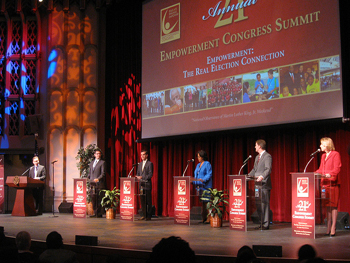 Mayoral candidates Emanuel Pleitez, Eric Garcetti, Jan Perry, Kevin James and Wendy Greuel answer questions at Empowerment Congress forum. Mayoral candidates Emanuel Pleitez, Eric Garcetti, Jan Perry, Kevin James and Wendy Greuel answer questions at Empowerment Congress forum. |
Candidates Eric Garcetti, Wendy Greuel, Kevin James, Jan Perry and Emanuel Pleitez spoke at the forum hosted by L.A. County Supervisor Mark Ridley-Thomas, who represents the Second District that covers South LA.. Candidates Yehuda Draiman, Addie Miller and Norton Sandler were not present.
Ridley-Thomas called the Congress to order shortly after 9:10 a.m. When he was a City Council member, Ridley-Thomas helped found the Congress in 1992 “to make government more accessible to the people.” He introduced Brad Pomerance, moderator of the debate. After the introduction, Pomerace discussed this year’s theme, “election connection.” He said the questions were submitted online and then chosen by the Empowerment Congress planning committee.
Garcetti, Perry and Greuel focused on their extensive records in city politics, while James and Pleitez positioned themselves as outsiders. “We have a jobs crisis, budget crisis, education crisis, transportation crisis, public safety crisis, corruption crisis,” James said. “We have a leadership crisis.”
South LA issues take center stage
All of the forum’s six questions came from Empowerment Congress members. One participant asked candidates directly if they supported a Leimert Park station along the new Crenshaw Line metro line. All five candidates said they support the station. “The community deserves it,” Greuel said.
Perry cited her work on the Expo Line, which opened in April, as evidence of her dedication to transit projects.
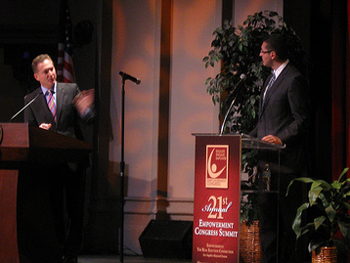 Mayoral candidate Emanuel Pleitez, right, answers a question from the moderator at the Empowerment Congress debate.
Mayoral candidate Emanuel Pleitez, right, answers a question from the moderator at the Empowerment Congress debate. Pleitez stood out for Brian Gaines, a University Park native. “The things that he said, it jelled… Being young and coming through the trenches,” he said. “I want to see something new… all the name-dropping wasn’t impressive to me either. But really, what are you going to do moving forward?”
James and Garcetti stood out to Sherri Bell, a South LA native who works with the Los Angeles Black Workers Center. “I definitely feel like I’ve been left behind,” she said. “It’s not just a gun problem, it’s not just a violence problem, it’s not just a lack of education problem. You have to really attack the things that contribute to that. I pay attention to the candidates who actually have a strategy.”
What to do with neighborhood councils
The forum’s fifth question was about how to engage the neighborhood councils in city decisions more. Each candidate agreed to empower them, but their methods varied. Gruel, for example, believes the councils need more power. She said that they have been “part of the decision-making processes” throughout her career and she will continue to “engage councils every step of the way.”
Pleitez added in his follow-up answer that council members need to be trained to deal with “real problems… It’s not about fighting for funding but actually being inside the decision-making process,” he said.
James proposed that each neighborhood council appoint a commissioner who would work directly with him.
Garcetti remarked, “[it is] time to start treating neighborhood councils like adults.” He said he would have the Department of Public Works talk to the neighborhood councils at the beginning of every year.
Finally, Perry defended councils fiercely. “It is life-changing to be able to listen to them,” she said. “It’s most important to preserve the neighborhood council system to continue discourse… We are not a threat to each other. We are partners with each other.”
The council discussion struck the forum’s attendees, too.
“I have watched them grow, I’ve watched them change, and it does take training,” said Dorsay Dujon, chair of the arts committee on the Arroyo Secco neighborhood council. “You just don’t go from your daily job and go into sitting on a board and recognizing and understanding all of the responsibilities that you have to that.”
Despite that need, Dujon believes much of neighborhood councils’ successes are their own. “It also takes a commitment on the part of the individual who’s on the neighborhood council to recognize that it’s not just about what you want for the community,” she said. “As much as it is a growing process for the councils themselves, it’s also for the neighborhoods to understand that they’re there for them.” Dujon supports Garcetti, Perry and Greuel; “in that order,” she said.
Other issues: Arts, homes, guns
The forum’s first question was, “How will you better utilize the power of the arts to revitalize South Los Angeles?” Pleitez, the first to answer, hesitated. He attributed the city’s unmanageable budget to pensions that “drain funds,” which means there is not enough money to spend on the arts.
Garcetti declared he would go to Sacramento in attempt to prevent additional cuts to public education, promising to “restore arts as the heart and soul of Los Angeles.”
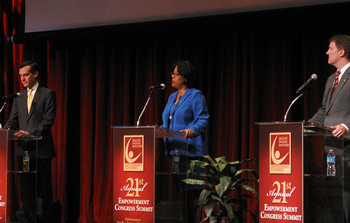 Mayoral candidate Jan Perry, center, answers a moderator’s question. Mayoral candidate Jan Perry, center, answers a moderator’s question. |
Perry promised to redirect the city’s public arts fee to private nonprofits. James agreed that the arts should be one of LA’s economic priorities, and Greuel argued for better supporting the entertainment industry.
Garcetti responded first to the second question: “Is the development of housing for the mentally ill homeless in your top three housing priorities?” He cited examples from his record as councilman for the 13th district. Perry also cited her record as councilwoman from the 9th district. “They need to have housing and a safety net,” she said.
James emphasized that this would be a priority for him, too. He said, “This crisis is not new…and has not [gotten] attention and priority it deserves.” Greuel added that also she wants to bring back the housing trust.
Pleitez agreed that this is one of his priorities if elected. However, he brought up the pension problem again and said pensions are his first short-term priority. He also discussed including mental health in public heath programs.
The forum also considered a timely national issue: “What will you do…that will actually reduce gun homicides?” Every candidate supports a comprehensive ban on assault weapons and background checks for concealed carry permits.
James added that he wants to “close the mental health records gap.” He also brought up an original idea, that of a “school marshal program,” which “provides anonymity and security” without actually stationing armed guards at schools.
Pleitez called gangs the city’s biggest purveyor of gun violence: he lost a friend in middle school to a gang shooting. As mayor, he wants to find a way to reintegrate gang members into non-violent life.
Greuel supports the plans put forward by President Obama and California Senator Dianne Feinstein. In addition, Greuel called for, “…prevention, intervention, and enforcement.”
Perry and Garcetti proposed regulations elsewhere: Garcetti plans to regulate ammunition sales, and Perry “introduced…divestment from companies that manufacture guns” as a councilmember.









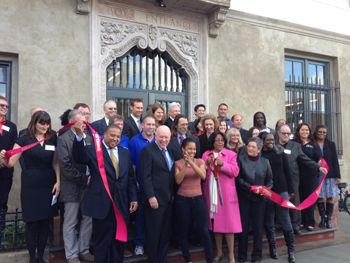
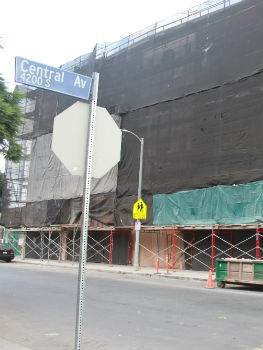

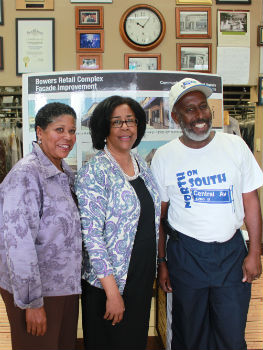
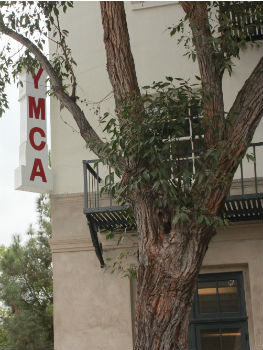
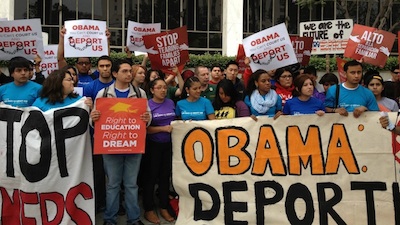 The United We Dream Network had scheduled a “Right to Dream” community mobilization for 8:30 on Friday, but organizers awoke to learn that the Department of Homeland Security (DHS)
The United We Dream Network had scheduled a “Right to Dream” community mobilization for 8:30 on Friday, but organizers awoke to learn that the Department of Homeland Security (DHS)  Hundreds of furious South LA residents attended today’s Los Angeles City Council meeting to protest the proposed redistricting map they believe would weaken the influence of African Americans and severely disrupt their community.
Hundreds of furious South LA residents attended today’s Los Angeles City Council meeting to protest the proposed redistricting map they believe would weaken the influence of African Americans and severely disrupt their community.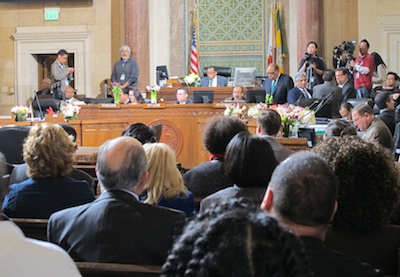 Despite the contentious public testimony, the City Council approved the map with new boundaries for the 15 council districts.
Despite the contentious public testimony, the City Council approved the map with new boundaries for the 15 council districts.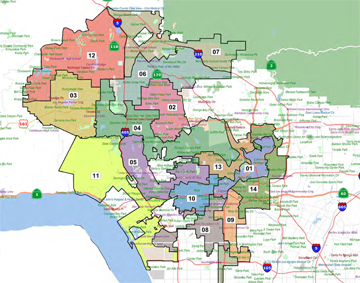 The opinions have been heard and the votes cast, but do you really understand the fuss over redistricting Los Angeles’ city council districts?
The opinions have been heard and the votes cast, but do you really understand the fuss over redistricting Los Angeles’ city council districts?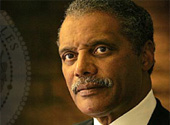 Today, Council President Herb Wesson
Today, Council President Herb Wesson 




